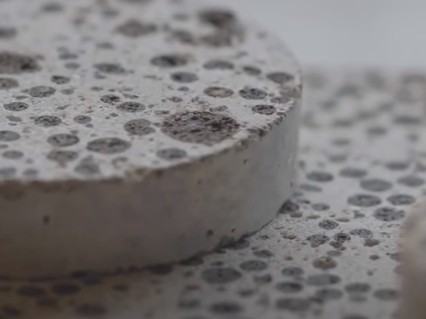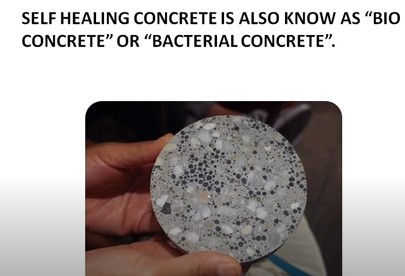What is self healing concrete?
Self-healing concrete was invented by a group of micro-biology researchers under the head of Henk Jonkers (Jonkers, 2011). Self healing concrete itself produces the lime that can heal the crack in the concrete when comes in contact with air, moisture.
Concrete is the mixer of cement, water, sand, and other aggregates in the proper ratio. It has high compressive strength and is the most important construction material for infrastructure. In normal concrete, cement can only heal cracks <0.2mm width by itself due to its autonomous property.

The concrete can withstand the compressive force but cannot withstand the tensile force and cause the cracks, is the reason for using the reinforcement in the concrete, to withstand the tensile force.
The cracks can be caused by various primary and secondary causes that can lead to structural damage and serious problem.
In a developing country like India, Nepal, Bangladesh, etc, there are huge use of concrete increases every day due to the rapid increase in construction. Concrete is one of the major used materials in the construction industry from the foundation of a building to the roofs, parking lot, bridge structures, etc.
While concrete has its own advantages but when concrete experiences tension it starts to crack.
The concrete can withstand the compressive force but cannot withstand the tensile force and cause the cracks, is the reason for using the reinforcement in the concrete, to withstand the tensile force.
The cracks can be caused by various primary and secondary causes that can lead to structural damage and serious problems.
The cracks developed in concrete enable the water to seep through it, the chance of freezing during winter increases causing the cracks in the concrete to increase. When the cracks are deep enough, they tend to reach towards steel reinforcement causing the steel reinforcement to corrode and causes serious damage.
Due to the cracking in the concrete, the repair works needs to be done in concrete. Repairing of the concrete can be very expensive and time consuming, not pro table. It will be challenging if the concrete crack appears underground and at great height. And this will de nitely compromise the durability of the concrete.
The cracks should be healed as soon as possible else it will become an easy way for the transportation of water and air and result in the destruction of concrete. The repair of concrete structures usually is done by applying a concrete mortar that is bonded to the damaged surface.
For solving this problem which arises in concrete we can use Mineral-producing bacteria which could help mend micro-cracking in concrete.
Why use self-healing concrete?
Self-healing concrete is the bacteria-based concrete that helps in healing the cracks in the concrete by itself, increasing the service life. it was invented by a group of microbiology researchers under the head of Henk M Jonkers.
Self-healing Concrete is also called Bio concrete or Bacterial Concrete. It’s specially made to increase the lifespan or the durability of concrete structure by the self-healing action of that concrete. A Bacterial genus named Bacillus is mixed with the healing agent.
The bacteria are capable of surviving in an extremely alkaline environment and can dormant up to 200 years. The bacteria are enclosed in the Beatles and start working when they are in contact with water and oxygen which occurs when the concrete cracks or deconstruct.
Types of bacteria used for self-healing concrete
- Bacillus pasteurizing
- Bacillus sphaericus
- Escherichia coli
- Bacillus subtilis
- Bacillus cohnii
- Bacillus balodurans
- Bacillus pseudofirmus
The bacteria from the bacillus species are mostly utilized for as self-healing agent in construction. It boosts the compressive strength as well as reduce the permeability of the concrete.
It prevents the corrosion of reinforced concrete by deoxidizing the oxygen coming from air due to crack. The bacteria are added directly while making the concrete so its cutback the maintenance and repairing.
Applications of self-healing concrete
- High strength building with more bearing capacity
- Long-lasting concrete life
- More durable roads
- Can be used in tunnel-lining structural basement walls, highways, bridges, concrete floors.
How does self healing concrete work? – Mechanism
When a structure is damaged due to several factors, it results in the formation of cracks that appear on its surface.
Damaged concrete allows water to seep in through its cracks, the encapsulated bacteria previously added to the mixture- now starts to germinate from the capsule on receiving enough nourishment from water and nutrients (calcium lactate added to the mixture).
The activated bacteria then start to feed on the calcium lactate present in the concrete which utilizes the oxygen present in the calcium lactate and converts soluble lactate into insoluble limestone. Thus, on solidi cation of the insoluble limestone, it seals up the damaged surface of the structure.


Figure 1: Bacteria spores multiplication in concrete
Chemical process
The unhydrated calcium present in the concrete when contracts water, the bacteria acts as a catalyst to convert unhydrated calcium into calcium hydroxide (Ca (OH)2), which in turn reacts with the atmospheric carbon dioxide to produce lime stone and water.
This occurs as a chain reaction due to the presence of water as a byproduct of reaction.

Preparation of bacteria concrete Two methods can be employed for the mixture preparation:
Direct Application method
In this method, the bacteria and its nutrient – calcium lactate – are directly added to the concrete mixture and hence, do not change the properties of the concrete mixture.
Encapsulation of Bacteria
In the encapsulation method, the bacteria and calcium lactate are placed inside clay pellets. The capsule method follows the same principle as with the aforementioned encapsulation in expanded clay.
The healing agent (Bacteria) is contained by the capsule membrane and will only be released when a crack has penetrated the capsule wall (Lucas, Moxham, Tziviloglou, & Jonkers, 2018). When clay pellets are broken by cracks the method of self-healing commences with the presence of water.
The capsules are an additive rather than a replacement for any of the major constituents. This, therefore, allows the initial compressive strength of the concrete, pre-crack, to remain high as the gravel aggregate will still be included.
The encapsulation of bacteria within the capsule is not an easy process. Specialized laboratory equipment is required, which in turn brings its own additional costs(Lucas et al., 2018). Minor cracks (0.5mm) width can be treated by using bacterial concrete.
Self-healing tests
Different authors have explored diverse methods and no standard process has been made available so far. Self-healing in the work by S.S. Lucas was determined following the equation (Lucas et al., 2018):
H (%) = [F(controlled)- F(healed)] \ F(controlled)*100%
where Fc is the compression strength for the control sample and Fh is the compression strength for the healed sample.
WHY SELF-HEALING CONCRETE IS IMPROTANT INCASE OF NEPAL?
Nepal on a regular interval witnesses’ earthquake along the major active faults in east-west alignment.
Historical data and ongoing seismological studies have clearly indicated that the entire region of Nepal is prone to earthquakes and it lies in the active seismic zone (V). Certainly, earthquakes cause cracks in concrete structures.
In the context of Nepal, Bio-Concrete or Self-healing concrete can be a good solution for the cracks in concrete to decrease the re-constructional works and even the time. Self-healing concrete not only reduces the reconstruction work but also the life span of the structures approximately 4 times.
Life Span and Cost of Self-healing concrete
The life span of the conventional concrete is 60-80 years while the life span of self-healing concrete is more than 200 years.
The initial cost of self-healing concrete is high (about double that of conventional concrete (Rs. 20000 per cubic meter)) but if the life of the structure can be extended by 30%, the doubling in the cost of the actual concrete would still save a lot of money in the longer term.
Limitation of Self-healing concrete
- Initially, the cost of self-healing concrete is more than traditional concrete.
- The design of bacteria mix concrete does not available easily.
- It needs proper care while preparing.
Read Also,
8 Points to improve the Durability of Concrete structure
Advantages and Disadvantages of concrete- Types of Concrete
Compressive strength of concrete | Compressive strength test on concrete
Difference between mortar and concrete | and Materials to prepare
Contributed by
Civil Engineer– Shreya Parajuli
Happy Learning- Civil Concept